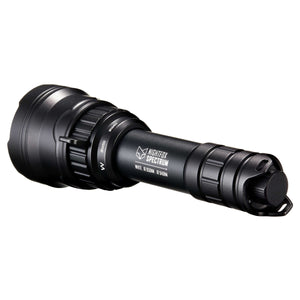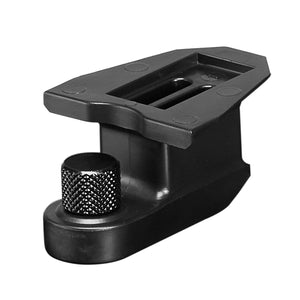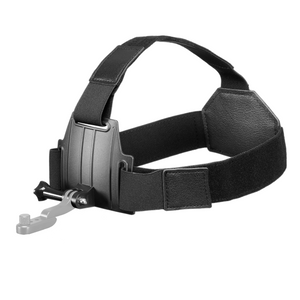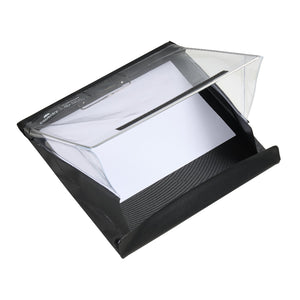0-9
850nm (Nanometers)
The term '850nm' refers to a common wavelength of infrared light used in many night vision devices. Unlike 940nm, 850nm light is more visible to the human eye but devices that operate at this wavelength can offer a brighter and clearer image in low-light conditions, making them suitable for security and tactical applications. Their slightly increased visibility means that users need to consider the balance between stealth and performance when choosing the appropriate wavelength for their needs.
940nm (Nanometers)
The term '940nm' refers to a specific wavelength of infrared light that is often utilized in night vision and thermal imaging devices. This wavelength is nearly invisible to the human eye, which makes it ideal for covert operations and wildlife observation. However, while these devices minimize visibility for humans, they may also have a reduced range and effectiveness compared to devices operating at 850nm.
A
Active Devices
Night vision devices that utilize infrared (IR) illuminators to cast additional or supplemental light on targets to enhance imaging capabilities.
Ambient Light
Ambient light refers to the natural, or artificial light, present in an environment before any additional lighting is applied. It is the general illumination that fills a space, influencing visibility and the capabilities of night vision devices.
Amplification
The process of increasing the brightness of light to enhance visibility in low-light conditions. In night vision devices, amplification refers to the enhancement of ambient light to make objects visible.
Analog Night Vision
A type of night vision technology that uses an image intensifier tube to amplify existing light. It offers a clearer image in low-light situations compared to regular optics.
B
Battery Life
The duration a device can operate before requiring a battery replacement or recharge. In night vision devices, battery life is critical for extended use during night operations.
Binocular
A binocular refers to an optical instrument designed for simultaneous viewing with both eyes, typically featuring two eyepieces.
C
CMOS
A 'Complementary Metal-Oxide Semiconductor' (CMOS) image sensor is a type of image sensor technology inside digital night vision devices.
D
Dark Adaptation
Dark adaptation is the physiological process by which the eyes adjust to low-light conditions, allowing enhanced sensitivity to light. This occurs when the photoreceptor cells in the retina, particularly the rods, become more sensitive as they adjust from bright environments to darkness, enabling better visibility in dimly lit settings.
Digital Magnification
Digital magnification refers to the process of enlarging an image using digital technology, often found in modern night vision devices. Unlike optical magnification, which relies on lenses to enlarge images, digital magnification involves electronically zooming in on a target, allowing for extended viewing distances without requiring additional optical components. This capability can enhance details in low-light conditions, although it may introduce some level of pixelation depending on the quality of the device.
Digital Night Vision
A digital night vision device is a type of optical instrument designed for low-light or night-time use that utilizes digital technology to enhance and display images. Unlike traditional (analog) night vision devices that rely on image intensifier tubes, digital night vision devices convert incoming light into electronic signals, which are then processed to create a clearer and more detailed image. These devices often feature additional functionalities such as image recording, zoom capabilities, and even video output, making them versatile tools for observation and surveillance in dark conditions.
Diopter
Diopters are used to indicate the adjustment capability of eyepieces, allowing users to fine-tune the focus for a clearer image based on their individual vision needs. This adjustment can significantly enhance the user experience, especially in low-light situations where precision is crucial.
Distance Magnification
The ability of a night vision device to increase the apparent size of distant objects. This feature is crucial for identifying targets during airsoft operations.
Dovetail Mount
A dovetail mount is a type of mounting system used in optics, including night vision devices, that features a dovetail design for secure attachment to firearms or optical platforms. This mount allows for easy installation and removal, providing a stable and reliable connection while enabling quick adjustments or replacements of the mounted equipment.
Here's a link to our dovetail mount for the Swift 1 and 2/Pro.
E
Exposure
In photography and videography, exposure refers to the amount of light that reaches the camera's sensor or film. It is a crucial factor in capturing images, as it affects brightness and detail. In the context of night vision, exposure settings can significantly influence image quality, allowing users to capture clearer visuals in low-light situations by adjusting the balance between the aperture, shutter speed, and ISO sensitivity.
Eye Relief
The distance from the last surface of an eyepiece to the position of the eye that provides a full field of view. It is an important specification in optical devices, particularly scopes and binoculars, as it affects comfort and usability for the user, especially when wearing glasses.
F
FOV (Field of View)
The extent of the observable area that can be seen through a night vision device. A wider FOV allows for better situational awareness, making it easier to spot potential threats.
FPS (Frames Per Second)
FPS, or frames per second, is a measurement used in video technology that indicates the number of individual frames or images displayed in one second of video playback. In the context of night vision devices, a higher FPS rate ensures smoother motion capture, which is crucial for observing moving subjects in low-light environments without blurring or distortion.
Fresnel Lens
A type of compact lens that focuses light using a series of concentric grooves. Some night vision devices utilize Fresnel lenses to enhance image clarity.
G
Gen 1
Gen 1 night vision technology is the first generation of analog night vision devices that typically use a photocathode tube to enhance low-light images. While they are the most affordable option, Gen 1 devices have a limited range and inferior clarity compared to later generations. They provide a basic level of night vision for close-range observations but may struggle in extremely low-light conditions.
Gen 2
Gen 2 night vision technology builds upon the capabilities of Gen 1 by incorporating a more advanced intensifier tube with better sensitivity and resolution. This results in improved image quality, clarity, and range. They perform markedly better in low-light conditions, making them suitable for tasks requiring more precise visual identification. Gen 2 devices also have a longer lifespan compared to their predecessors.
Gen 3
Gen 3 analog night vision devices are currently the most advanced commercially available technology. Utilizing gallium arsenide in the photocathode and improved optical components, Gen 3 devices offer superior image quality, greater sensitivity to light, and an extended operational range. They excel in very low-light environments and provide clear, high-resolution images, making them ideal for military, law enforcement, and tactical applications. Gen 3 devices are often seen as the gold standard in night vision technology.
Green Filter
A green filter is an optical filter that allows only green light to pass through while blocking other wavelengths of light. In analog night vision devices, green filters are commonly used because the human eye is most sensitive to green light. Green light enhances contrast and visibility in low-light conditions, creating more comfortable and clearer images for the user during night-time operations.
I
Infrared Illumination
A light source that emits infrared radiation, which is invisible to the human eye, used to enhance visibility in night vision devices. It helps to improve sensitivity and range in low-light conditions by providing supplemental light for imaging, particularly in total darkness.
Infrared Illuminator
A device that emits infrared light to improve visibility for night vision equipment. It allows users to see in complete darkness without giving away their position to the naked eye.
Infrared (IR) Light
A type of radiation that is invisible to the human eye but can be sensed by night vision devices. Infrared illuminators enhance visibility in darkness by providing light that night vision devices can pick up.
L
Latency/Lag
Latency, often referred to as lag, is the delay between the initiation of an action and the moment it is perceived by an observer. In the context of night vision technology, latency can refer to the time it takes for light to be converted into an image by the night vision device. High latency can result in a noticeable delay in visual display, which may impact the user’s ability to respond quickly in critical situations, particularly during tactical operations. Efficient night vision systems aim to minimize latency to provide real-time visual feedback.
Lumen
A lumen is a unit of measurement for the perceived power of visible light, quantifying the total amount of light emitted by a source that is visible to the human eye.
M
Military-Grade
Military-grade refers to products or equipment that meet stringent standards set by military organizations for durability, reliability, and performance in extreme conditions. These items are often subjected to rigorous testing for factors such as temperature, humidity, shock, and vibration, ensuring they can withstand harsh environments and demanding operations typically required in military applications. In the context of night vision technology, military-grade devices are built to perform exceptionally well in challenging scenarios, offering enhanced features and durability compared to standard consumer models.
Monocular
A monocular is a single-lens optical device designed for magnifying distant objects, similar to a small telescope. In the context of night vision, monoculars are portable, lightweight devices that enhance visibility in low-light conditions. They typically offer a one-eye viewing experience and are favored for their ease of use and versatility in various applications, such as wildlife observation, navigation, and security operations.
N
Night Blindness (Nyctalopia)
A visual impairment characterized by difficulty seeing in low light or dark conditions, often due to retinal issues, vitamin A deficiency, or other underlying health problems. Individuals with night blindness may struggle to adapt to changes in lighting, making night-time navigation challenging.
Night Blindness (Screen-Induced)
A temporary visual impairment that occurs when transitioning from a brightly lit screen to a darker environment, resulting in difficulty seeing clearly in low light conditions. This phenomenon can be exacerbated by prolonged screen exposure, which may cause the eyes to struggle to adjust to reduced light levels, leading to a sensation of temporary blindness or impaired vision when attempting to see in the dark.
NODS (Night Observation Devices)
NODS refers to a range of night vision equipment, including goggles and monoculars, designed to enhance visibility in low-light or total darkness. These devices utilize advanced image intensification or thermal imaging technologies to provide users with improved visibility without the need for ambient light. NODS are commonly used in military, law enforcement, and outdoor recreational activities, allowing for effective observation and navigation in nocturnal environments.
NVG (Night Vision Goggles)
Head-mounted devices that provide enhanced vision in low-light conditions. NVGs combine magnification and image intensification technologies.
O
Optical Magnification
Optical magnification is the process of enlarging the appearance of an object through the use of lenses or optical systems. By bending light rays, these systems allow the human eye to see distant or small objects more clearly and in greater detail. In night vision devices, optical magnification works in conjunction with other technologies to enhance visibility in low-light conditions, providing users with a clearer and more expansive view of their surroundings.
P
Passive Devices
Night vision devices that rely on natural ambient light, such as moonlight or starlight, to create images, without the use of additional infrared illumination.
Phosphor
Phosphor is a luminescent material that emits visible light when excited by radiation. In analog night vision devices, phosphors are used in image intensification tubes, where they convert the amplified low-light signals into a visible image. The composition and characteristics of the phosphor affect the brightness, color, and clarity of the image, playing a crucial role in the quality of night vision technology.
Pixel Resolution
The number of pixels that create an image in a digital device. Higher pixel resolution leads to clearer and more detailed images in night vision devices.
R
Range
In the context of night vision devices, 'range' refers to the maximum distance at which a user can detect and identify objects clearly in low-light or complete darkness. The range is influenced by several factors, including the sensitivity of the device's image intensification, the quality of the optics, and the ambient lighting conditions. A greater range enables users to observe targets from farther away, enhancing situational awareness in nocturnal environments.
Reticle
A grid pattern or aiming point within the scope of a night vision device, often used for precise targeting. Some airsoft guns come equipped with night vision scopes featuring illuminated reticles.
Rhino Mount
A Rhino Mount is a type of attachment mechanism used in night vision devices, particularly goggles, allowing for secure and adjustable mounting to a helmet or headgear. This design provides ease of use and flexibility, enabling users to quickly switch between different configurations or remove the device when not needed, making it a popular choice among military personnel and outdoor enthusiasts.
Here's a link to rhino mounts available on Amazon.
RIF (Replica Imitation Firearm)
A "RIF" stands for Replica Imitation Firearm, which is a non-functioning replica of a firearm often used in airsoft or training scenarios. These replicas are designed to closely resemble real firearms in appearance and weight but do not operate with live ammunition. Due to their realistic look, RIFs are typically subject to specific regulations regarding their use and transport, especially in public spaces.
S
Sensitivity
The capability of a night vision device to detect light in low-light situations. Higher sensitivity means better performance in darkness.
Sensor
A sensor in night vision technology is a component that detects and converts incoming light into an electrical signal, which is then amplified to create a visible image. Sensors play a crucial role in the overall effectiveness and quality of night vision devices, directly impacting their ability to function in varying light conditions.
Signal-to-Noise Ratio (SNR)
A measure of the light signal captured by an image intensifier relative to the perceived noise, indicating the clarity and quality of the image in low-light conditions. A higher SNR signifies better performance, allowing for improved resolution and visibility of objects in dark environments.
Stereoscopic Vision
Stereoscopic vision is the ability to perceive depth and dimensionality by combining visual information from both eyes. This phenomenon occurs because each eye views an object from a slightly different angle, allowing the brain to interpret the distance and spatial relationships between objects. In the context of night vision, devices that incorporate stereoscopic vision can provide users with a more immersive and accurate perception of their surroundings, enhancing their situational awareness in low-light conditions.
T
Thermal Imaging
A technology that detects infrared radiation (heat) emitted by objects, allowing users to visualize and identify objects based on their thermal signatures. Unlike night vision, which amplifies visible light, thermal imaging is effective in complete darkness and can penetrate obscurants like smoke or fog. This makes it valuable for various applications, including search and rescue operations, security, and wildlife observation.
Transducer
A component that converts energy from one form to another. In night vision devices, a transducer often converts light (or infrared radiation) into an electrical signal, amplifying it for clearer visibility in low-light environments.
U
UKARA
UKARA stands for the 'United Kingdom Airsoft Retailers Association', which is an organization that regulates the sale and use of airsoft guns in the UK. It ensures compliance with legal requirements and promotes responsible practices among retailers and players. UKARA registration is often necessary for individuals looking to purchase airsoft guns, as it verifies that the buyer is a member of a recognized airsoft skirmish group.
V
Visible Spectrum
The visible spectrum refers to the portion of the electromagnetic spectrum that can be detected by the human eye, typically ranging from wavelengths of 380 nanometers (violet) to 750 nanometers (red).
Visual Acuity
The clarity or sharpness of vision. In night vision devices, visual acuity is crucial for distinguishing details of objects in low-light conditions. Higher visual acuity in night vision technology allows users to accurately identify targets or navigate effectively.
Video Night Vision
A type of night vision technology that captures and records images or videos in low-light conditions. This technology often combines night vision capabilities with recording devices, allowing for surveillance, documentation, or study of nocturnal activities.
W
Wavelength
The distance between successive peaks of a wave, particularly in the context of light. Different wavelengths of light are processed differently by night vision devices; for example, infrared light has a wavelength longer than that of visible light, allowing thermal imaging to detect heat signatures.
Y
Yield
In the context of night vision devices, yield refers to the effectiveness or performance output of a night vision system in terms of its ability to produce usable images in low light. A high yield indicates a reliable device that consistently delivers clear visuals.
Z
Zoom Functionality
A feature available in some night vision devices that allows users to magnify an image or target for closer inspection. This can enhance situational awareness by making distant objects clearer, thereby aiding in identification and analysis during night operations.
Zeroing
The process of adjusting the alignment of a night vision device with a weapon's sighting system to ensure accuracy when aiming. Proper zeroing is crucial for improving the effectiveness of targeting in low-light shooting scenarios.

 Trusted Service
Trusted Service 30 Day Return Policy
30 Day Return Policy 2 Year Warranty
2 Year Warranty Worldwide Delivery
Worldwide Delivery 






































